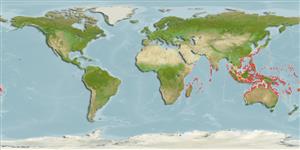Classification / Names
Common names from other countries
Main reference
Size / Weight / Age
Max length : 23.0 cm TL male/unsexed; (Ref. 2334); 23.0 cm NG (female)
Environment
Marine; reef-associated; depth range 10 - 28 m (Ref. 9710)
Climate / Range
Tropical, preferred ?
Distribution
Short description
Dorsal
spines
(total): 5;
Dorsal
soft rays
(total): 21;
Anal
spines: 1;
Anal
soft rays: 17 - 18. Has a white mid-lateral stripe from the upper pectoral base to the tail. Males have narrow diagonal lines on the cheek. (Ref. 37816). Fine spotting over the back (Ref. 48636). Scales on back above white stripe with dark edges, many with outer half dark brown. An orange-yellow bar at base of pectoral fins (Ref 42740).
IUCN Red List Status (Ref. 115185)
Threat to humans
Harmless
Human uses
Aquarium: commercial
More information
Common namesSynonymsMetabolismPredatorsEcotoxicologyReproductionMaturitySpawningFecundityEggsEgg development
ReferencesAquacultureAquaculture profileStrainsGeneticsAllele frequenciesHeritabilityDiseasesProcessingMass conversion
Tools
Special reports
Download XML
Internet sources
Estimates of some properties based on models
Phylogenetic diversity index
PD50 = 0.5000 many relatives (e.g. carps) 0.5 - 2.0 few relatives (e.g. lungfishes)
Trophic Level
3.6 ±0.4 se; Based on size and trophs of closest relatives
Resilience
Medium, minimum population doubling time 1.4 - 4.4 years (Preliminary K or Fecundity.)
Vulnerability
Low to moderate vulnerability (30 of 100)
Price category
